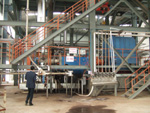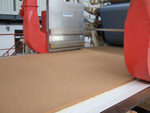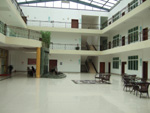Weihua’s third
17 August 2009In his report from Weihua’s newest factory in FengKai, Guangdong province, Mike Botting listed the nine lines owned by this rapidly expanding panel manufacturing group (see WBPI issue 3, 2009, p24). Those nine lines – three multi-opening and six continuous – give the company a total output capacity in the region of 1.5 million cubic metres of MDF/HDF in China.
The line that is the subject of this story is located in Jiuji Town, Xiangfan City, Nanzhang County, in Hubei province and was the third continuous press for the Weihua Group.
Hubei Weilibang Wood Working Corporation, a member of the Guangdong Weihua Corporation, is located on a new industrial site on former agricultural land and is one of only two factories there. It is about three to four hours’ drive from Wuhan, the nearest large city in Hubei province.
This Weihua group factory covers an area of around 400mu (27ha). After passing through the group’s signature entrance gate to the site (designed to represent trees on the one side and panels on the other in an abstract way and common to all Weihua sites), one approaches the impressive office building.
Inside is a large atrium with balconies surrounding it on all sides leading to offices on the upper two floors. This atrium also features a stone wall with waterfall feature with the water falling into a large fish pond. All very tranquil.
Construction of these offices, the apartments for the workers and the canteen/social building began in March 2007. The site also contains a ‘hotel’ block
for visiting engineers and customers as the drive from Wuhan is long and
rather tedious.
Weihua, in common with most Chinese panel makers, builds its offices and accommodation before the factory buildings, rather than using temporary buildings until after the line is running as is the practice in some other countries.
The contract for the machinery for the MDF/HDF production line was also placed in March 2007, with the main part of the line being awarded to Dieffenbacher of Eppingen, Germany.
Capacity of the line is around 150,000m3 a year and the main thickness produced is 4.75mm for customers who produce laminate flooring and doors.
I asked the vice general manager at Xiangfan why the company chose this location. He gave a two-pronged answer:
“Firstly we have access to a good wood raw material supply as there is a good supply in Hubei province and not many industries utilising it – there is only PTP Hubei’s MDF line, Baoyuan MDF and ussaid Li Bao Ming.
“Secondly, we are close to Wuhan, which is a city with a good market for the trading of all wood products. Fifty percent of our production goes to Wuhan and 50% of that goes to two laminate flooring manufacturers there. In fact, one customer has just placed a contract for 5,000m3 a month.”
That all-important wood supply is made up of 40% pine, 20% poplar and 40% mixed wood species – all of it plantation-grown and apparently within an unusually small, 40km, radius.
“Weihua has its own 50,000mu (3,350ha) plantation in the local area,said Mr Li. “The company supplies the seed to the farmers and buys the trees from them at the market price.”
As a group, Weihua has 650,000mu of plantations of fast-growing, high-yield forest in Guangdong province, here in Nanzhang County in Hubei province and in Handan City in Hebei province.
Waste wood supplies the fuel for the GTS Energy system and is supplemented with bought-in sawdust which is available locally very cheaply, according to Mr Li.
Chipping of the incoming wood is carried out by Pallmann machinery and all chips are produced on site, not bought in.
Pallmann, of Germany, also supplied the refiner, which is a 52in diameter unit.
Dieffenbacher supplied the equipment from the drying area to the finishing line, including a CPS continuous press that is 24.2m long and eight feet wide, with a Sandvik stainless steel endless belt.
This line was ordered at a time when all European machinery makers had very healthy order books and Dieffenbacher had a policy of making use of some of its manufacturing facilities outside its Eppingen headquarters, where its quality standards could be guaranteed. Hence the hot platens for the Xiangfan CPS press were made at Dieffenbacher North America Inc’s factory in Windsor, Ontario, Canada.
Like most Weihua factories, Xiangfan is equipped with an Anthon of Germany cut-to-size system and a Steinemann sander.
The sander was originally purchased as a six-head machine but by September 2008 Weihua had decided that it needed to be an eight-head and ordered an extra two heads from Switzerland. The enlarged sander was due to go into operation in June.
In common with all other nine Weihua lines, Xiangfan has its own resin making plant.
Inevitably, I asked Mr Li how his factory was coping with the economic downturn.
“In the current economic situation we are paying more attention to board quality than to output,he said. “We want to produce a very good quality product and because our production only started last September, it takes time to learn and to train the people to increase the quality of the board. If we were to go for full-capacity production, maybe the quality would not be so good.”
For the higher level staff, Mr Li said that they came from other Weihua Group operations, bringing their production experience with them. For new staff, over 90% were sent to the company’s first CPS line in Qingyuan, Guangdong province, for a year for training. Xiangfan employs a total of 280 staff. Total investment in the Xiangfan project was RMB370m (US$54.3m).
Whilst each Weihua factory has someone responsible for its sales, overall sales policy is centrally directed from the group headquarters in Guangzhou.
“The whole Weihua Group pays attention to board quality and different factories supply different types of board to make a big product range and expand our customer base,explained Cheng Da, sales manager at Xiangfan.
“The average price of the board has reduced by roughly RMB400/m3 (US$59) between August 2008 and now – from RMB2200 to RMB1800 – maybe less today,said Mr Cheng in late April.
Weihua has considered diversification from its MDF/HDF product range and had in fact drawn up plans for the group’s first blockboard line to be built on the Xiangfan site. However, the economic situation has caused the company to rethink those plans and to put the development on hold.


